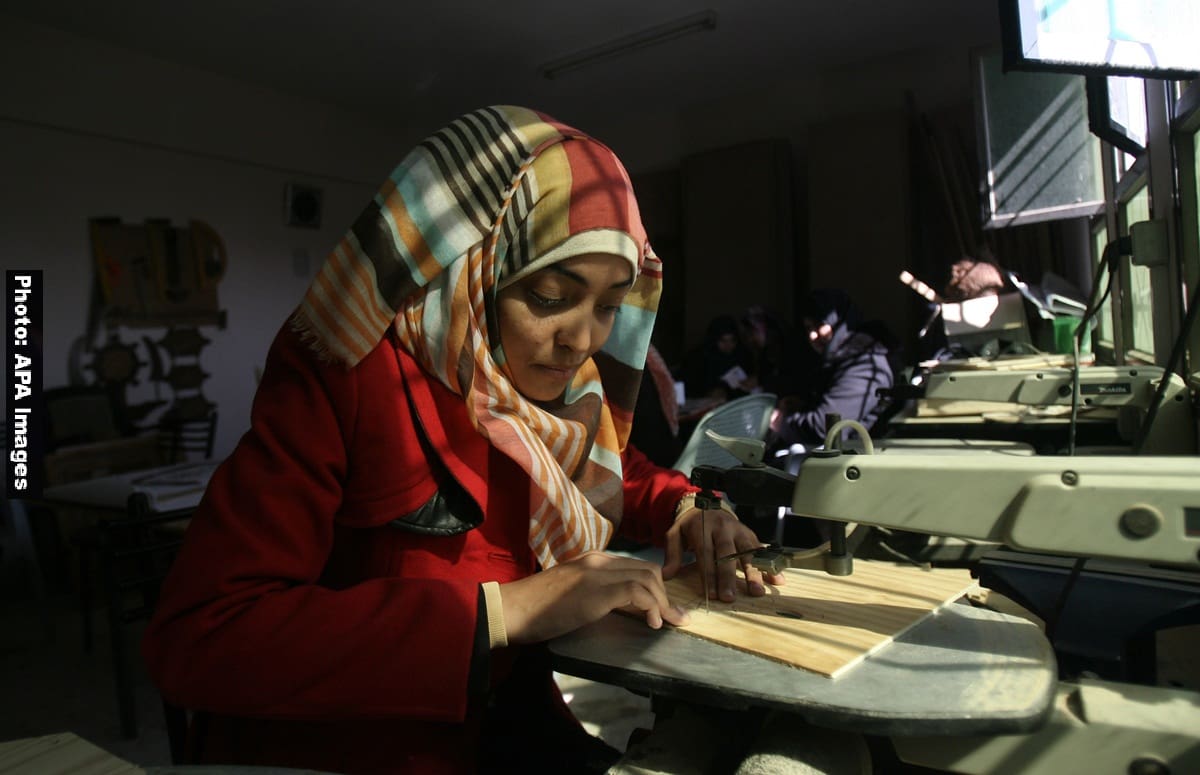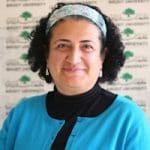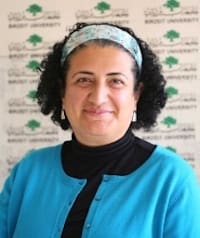
Executive Summary
Palestinian women have one of the lowest rates of labor force participation in the world -despite higher primary and secondary enrollment ratios than males in the entire Middle East and North Africa. Al-Shabaka Policy Advisor Samia Al-Botmeh examines the trends and proposes policies that move beyond the supply side to focus on demand for women’s labor.
Key Points
- Palestinian women’s participation in the labor force is much lower than in the rest of the Arab World, despite higher levels of primary and secondary education.
- The fact that women’s participation is highly concentrated in agriculture and services, while employment in manufacturing has declined, is a result of Israel’s systematic destruction of Palestinian productive sectors since 1967.
- Gaps in the credit system have deterred women’s entrepreneurship, while secondary education skewed toward literary studies have inadequately equipped women for the work force.
- Reforms must address demand side factors for women’s labor by protecting and promoting local production.
A Declining Share in Productive Sectors and More Segregation
In 2014, Palestinian women’s labor force participation rate in the OPT stood at 19.4% compared to 25% in the Arab region and 51% in the rest of the world. This is particularly striking given that Palestinian girls’ primary and secondary school enrollment ratios are higher than boys in the entire Middle East and North Africa region.
Palestinian women’s participation in the labor market is highly concentrated in agriculture and services, yet virtually non-existent in construction and transport. Women’s participation in the manufacturing sector has declined since 1995, suggesting that the segregation of women into a few sectors is actually rising over time. Further, Palestinian women have persistently earned only around 80% of men’s wages in the West Bank and Gaza Strip.
Women’s entrepreneurship accounts for only about 15% of women’s employment at best and has not exhibited any major increases over the past 15 years. On the other hand, 65% of Palestinian women are willing to launch a business, indicating a clear discrepancy between potential entrepreneurship and actual outcomes.
Israel’s Undermining of the Economy and Other Factors
The compression in the demand for labor as a result of Israel’s systematic destruction of the Palestinian agriculture and manufacturing sectors is the paramount factor explaining the low female labor force participation rates. The geographic, physical and social ruptures created by checkpoints and permanent closures within the West Bank and Gaza have had a serious impact on Palestinians’ mobility, making it more difficult for women than men to seek employment outside their local communities.
In addition, women entrepreneurs face more hurdles in accessing commercial credit than men do for a number of reasons, including lack of the collateral necessary to access commercial loans. Although bank lending has risen substantially in the past few years, it is irrelevant to women’s entrepreneurship and the sectors that employ women.
The growing imbalance in secondary enrollments in favor of the literary stream has increased the percentage of students who leave school without qualifications or skills. This has serious repercussions as women tend to be concentrated in teaching, nursing and secretarial work.
Palestinian labor law number seven currently excludes large segments of the work force including spheres in which women are predominantly located. The labor law must include a clear clause for equal treatment between men and women, and specify penalties for employers who violate this article of the law.
Policy Focus on Demand Side and Challenge Israel’s Erosion of the Economy
Policy interventions must design practical interventions which promote the demand for women’s labor. Policies must also challenge Israel’s continued efforts to undermine the productive capacity of the Palestinian economy, and put in place trade policies that prioritize protecting production over opening local markets to international competition before they are ready to compete.
- The best opportunity to expand the productive sectors (agriculture and manufacturing) would be to replace imports of Israeli goods and services by local production. Emphasis should be placed on the more
Overview
Palestinian women in the Occupied Palestinian Territory (OPT) have one of the lowest female labor force participation rates in the world. Al-Shabaka Policy Advisor Samia Al-Botmeh points out that, while this would be problematic in any context, it is even more so under conditions of settler colonialism, as in the OPT. Among other reasons, women’s labor force participation is a critical development indicator that both developed and developing countries actively strategize to boost, in part because it is one of the drivers of economic growth. Moreover, in many developing countries women’s labor force participation indicates the capacity of a society to withstand economic shocks with minimal social fragmentation. Finally, the higher the women’s participation rate and employment under “decent work” conditions the greater the prevalence of gender justice within that society.1
In short, weak economic and social outcomes, including stagnant growth, social fragmentation and gender bias, may undermine the capacity of the colonized population to withstand, survive and resist colonialism. Al-Botmeh builds on her previous work by first describing the features of women’s labor market trends and then examining the factors shaping these trends 2. She concludes with policy recommendations aimed at boosting women’s participation in the labor market in the OPT while at the same time challenging Israel’s efforts to undermine the Palestinian economy.
A Declining Share in Productive Sectors and More Segregation
In 2014, Palestinian women’s labor force participation rate in the OPT stood at 19.4% compared to 25% in the Arab region and 51% in the rest of the world3. This is particularly striking given that Palestinian women have high educational rates: By 2000, Palestinian girls had higher school enrolments rates and lower dropout rates than boys. Indeed, Palestinian girls’ primary and secondary school enrolment ratios are also higher than boys in the entire Middle East and North Africa region.
Palestinian women’s engagement in the labor market increased from 11.2% in 1995 to 19.4% in 2014, a significant rise despite remaining below the regional average. However, this rising trend also translated into a higher increase in unemployment compared to employment. In other words, despite the fact that there was a rise in women’s labor force participation, women were more likely than men to become unemployed.
As in other parts of the Arab world, Palestinian youth face substantially higher rates of unemployment than older workers. Young women’s unemployment rate can reach four times that of older women while young women’s unemployment rate is nearly double that of men in the same age group.
At the same time, Palestinian women are highly concentrated in two sectors of the economy – agriculture and services – and virtually non-existent in another two, construction and transport. By 2014 agriculture accounted for 21% of women’s employment compared to 67.3% in services. This concentration implies that women do not have equal access to all sectors compared to men. Although this is a worldwide phenomenon, the Palestinian case tends to be extreme; as a result, Palestinian women experience a higher degree of marginalization in the labor market compared to women in other economies.
More importantly, over the past 20 years, the share of women’s employment in the productive sectors (agriculture and manufacturing) continued to decline, while their share of employment in services and commerce rose. This is particularly significant because it is the productive sectors that generate long lasting growth within an economy. In 1995, the manufacturing sector accounted for 16.2% of women’s employment but declined to only 9.9% by 2014. Such a decline implies that the segregation of women into a few sectors (horizontal segregation) is actually rising over time. As a result, their prospects for future employment may be further negatively affected. Moreover, the service sector, which witnessed the fastest expansion since 1995, has reached its limit in absorbing women. Palestinian women also suffer from vertical segregation, that is the difference in earnings between men and women due to women’s inferior position in the labor market: Women have long earned around 80% of men’s wages in the West Bank and Gaza Strip.
Entrepreneurship, which is an important economic indicator of creativity and future employment potential, remains very low in the OPT according to available data. For example, only 14% of 15-29 year olds have tried to set up their own income generating activities, of whom only 6% are female. Women’s entrepreneurship has stagnated: According to the annual PCBS Labour Force Survey the two categories that represent entrepreneurship (self-employed and employer) accounted for nearly 15% of women’s employment at best and did not exhibit any major increases over the past 15 years. On the other hand, 65% of Palestinian women are willing to launch a business, which indicates a clear discrepancy between potential entrepreneurship and actual outcomes. Reasons include lack of practical vocational training and inadequate sources of financing. Other factors include the Palestinian Authority’s neoliberal economic policies that do not provide any protection for the local market from unfair competition, particularly the Israeli goods and commodities that flood the local market and erode the local Palestinian economy’s productive capacity.
To sum up, although women’s participation trend is rising during the past 15 years, it remains very low. The fact that more women experienced unemployment compared to men raises questions about the role of political and institutional factors that keep women’s participation rates well below their regional average. In addition, the exclusion of young women from the labor market, as well as the low percentage of female entrepreneurs point to demand-side obstacles.
Israel’s Undermining of the Economy and Other Factors
There are a number of factors behind the unfavorable trends in women’s labor market engagement. Israel’s settler colonialism plays a major role: The geographic, physical and social ruptures created by Israel’s checkpoints and permanent closures of entrances and exits to several places of residence have had a serious impact on Palestinians’ mobility, particularly that of women. The uncertainty created in commuting time as a result of Israel’s movement restrictions makes it more difficult for women to seek employment outside their local communities thus reducing their work chances, even compared to men.
Israel’s colonialism has also contributed towards higher unemployment among women compared to men. Palestinian workers in Israel and the settlements always have been predominantly male, whereby 12% of male workers were employed in Israel in 2014, compared to less than 1% of working women. This meant that the economy in the OPT has become even more competitive for women, which partially explains the extremely high unemployment rates for women in the post-Second Intifada period.
Other factors affecting labor force participation, particularly women’s, include the demand for labor, the availability of employment and the structure of employment, and incentives offered by the labor market 4. The compression of the demand side was caused by the erosion of the productive capacity of the Palestinian economy due to Israel’s systematic destruction of the agricultural and manufacturing sectors along with much infrastructure. This compression of the demand-side of the labor market and the resultant unavailability of employment has been pivotal in shaping Palestinian women’s labor market engagement throughout most of the last century 5. The continued undermining of these two sectors as well as their capacity to employ women, have contributed to distorting incentives for women and locking them away from the labor market. Since these two sectors are particularly important in employing women anywhere in the world, the fact that they do not provide needed work implies that Palestinian women do not perceive that they have a place in the labor market. In other words, over time Palestinian women may have become discouraged from joining the labor market.
More specifically, this policy brief argues that the compression in the demand for labor as a result of Israel’s systematic destruction of the Palestinian economy’s productive sectors of agriculture and manufacturing is the paramount factor explaining the low female labor force participation rates. This became evident in the post-Second Intifada period when the local economy was further compressed. The higher unemployment rates recorded for women compared to men during this period meant that the demand side of the labor market presents significant impediments to women’s participation despite women’s high educational rates.
In addition to demand side considerations, the availability of credit, particularly for new investments, may hinder entrepreneurship, hence reducing labor market participation. As is the case elsewhere in the region, women entrepreneurs face more hurdles in accessing commercial credit compared to men for a number of reasons, including lack of the collateral necessary to access commercial loans and the small and family-based nature of enterprises run by the vast majority of women in the Middle East 6 .
Although bank lending has risen substantially in the West Bank and Gaza Strip in the past few years, to reach $3.3 billion in 2013 compared to $300 million in 1996, this lending has been mostly directed at consumption. Nearly $2 billion were spent on consumer loans, another $1.2 billion on real estate development, while investment schemes and land development accounted only for $136 million. Hence, despite the fact that formal credit has been extended widely in the OPT it is irrelevant to women entrepreneurship and employment, particularly since women do not engage in real estate development and the construction sector.
Beyond formal credit, women’s projects in general have become primary beneficiaries of microfinance programs. This also has been the case in the OPT, where microfinance has been expanding since the 1980s while being skewed towards women. It is often claimed that microfinance creates a space for economic empowerment through giving women’s small enterprises and the poor access to credit. While providing access to credit is very important, microfinance projects in other countries have been blamed for setting up a poverty trap, saturating the informal economy with small, unsustainable economic enterprises that compete with another with limited long-term economic horizons.
As regards the contribution of education to women’s labor market participation, streaming in schools has been biased towards subjects that do not help women in the labor market. Secondary education in the OPT is divided into academic courses (literary and science) and vocational education. The literary stream accounts for the largest percentage of female students: 70% in 2010/2011 compared to only 23% in the scientific stream. This has serious repercussions for students’ skills and later demand for tertiary education and the labor market where they tend to be concentrated in typical women’s jobs, including teaching and nursing.
The growing imbalance in secondary enrolments in favor of the literary stream has increased the percentage of students who leave secondary school with no qualifications or skills. These problems become even more serious considering that vocational education is not a real option for secondary school students and fewer girls than boys enroll in vocational streams. Hence, the opportunities for girls remain concentrated in commercial streams such as secretarial.
At the same time, higher female enrolment rates in tertiary education – be it vocational or academic – does not seem to help these women in the labor market partly because their education is limited to a few stereotypical domains. This implies that women’s choices and skills in the labor market are partially predefined through the nature of their enrolment in schools and higher education institutions. This is an important area that requires policy interventions to broaden the scope of subjects in which women are involved in order to aid their participation across different sectors in the labor market.
Legal and institutional factors also contribute to limiting women’s participation in the labor market. Palestinian labor law number 7 (which went into effect 25 December 2001) currently excludes large segments of the Palestinian labor force including: Self-employed workers, seasonal workers, unpaid family workers, domestic workers and those involved in unpaid domestic care and reproductive work at home. Women are predominantly located in these spheres. In addition, although the labor law is clear in its clause for equal treatment between men and women, it does not specify penalties for employers who violate this article of the law. Nor does the law require work establishments to provide nursery facilities for working mothers or even fathers who have children in the pre-school age.
These and other weaknesses and gaps demonstrate that the law is clearly not sufficiently gender sensitive and does not protect and promote women’s rights. The fact that the majority of women are not unionized and the Palestinian women’s movement is not unified and well-organized to advocate for working women’s rights explain why the labor law does not fully address these rights 7.
Palestinian private sector employers have complained regularly about the mandated maternity leave for women. They consider 10 weeks leave to be too long and, in the absence of support from the government, they claim that this requirement negatively affects their profits. As a result, employers have either employed fewer young married women or have dismissed women once they get married 8.
In conclusion, the above section has discussed a number of supply, demand and institutional factors which have hindered Palestinian women’s participation in the labor market. Although the coverage of these factors is not exhaustive, this policy brief primarily argues that the compression in the demand for women’s labor as a result of Israel’s systematic destruction of Palestinian productive sectors since 1967 has been the main factor undermining Palestinian women’s participation in the labor market. This is the unique feature that characterizes the Palestinian context compared to the rest of the Arab world and that has led to Palestinian women’s participation remaining below the regional average. Hence, despite the shared social norms in the OPT and neighboring Arab countries, as well as the higher educational rates in the OPT, Palestinian female labor force participation rates remain among the lowest in the world and lower than the regional average.
Policy Focus on Demand Side and Challenge Israel’s Erosion of the Economy
Policies and actions addressing female labor market participation in the OPT have mostly focused on the supply side of the labor market. These include equipping women with education and skills to improve their chances of competing in the labor market and campaigns to tackle some of the institutional impediments facing women in the market such as the labor law. Although these initiatives are important, policy interventions must also focus on the inter-linkages between the supply and demand sides of the labor market and to design practical interventions which promote the demand for women’s labor.
Since Israel’s settler colonialism is the underlying factor hindering the expansion of women’s labor force participation because of its erosion of the productive capacity of the Palestinian economy, policies must also challenge Israel’s continued efforts to undermine production. As noted earlier, enhancing the productive capacity of an economy is significant for the generation of long lasting employment, particularly work for women. In the Palestinian context, enhanced productive capacity will strengthen Palestinian steadfastness through lessening economic dependency on Israel and thus Israel’s capacity to bring the Palestinians to their knees whenever it wishes to. This can be achieved by establishing the link between production and trade policies as discussed further below.
Furthermore, the Palestinian Authority (PA) should move away from its neoliberal economic policies, which have contributed to the continued erosion of the productive capacity of the Palestinian economy. This includes abandoning its policies of non-protection of the local economy using the pretext of World Bank and International Monetary Fund dicta of promoting competition and open trade. As has been the case elsewhere, protection of production should precede opening local markets to international competition. Under the PA’s neoliberal economic policies, the OPT has been one of the least protected economies in the world, which leaves it exposed to exploitation, particularly by Israel. Contrary to the PA’s claims that its hands are tied under the Oslo Accords and the Paris Economic Protocol, measures can be taken, as explained below.
Expanding Demand for Women’s Labor While Challenging Israel
- In order to provide a strategic solution to the problem of women’s low participation and high unemployment, policies have to aim at expanding the size of the productive sectors (agriculture and manufacturing) to absorb women. These sectors are women-dominated worldwide: By expanding work opportunities in these sectors, women’s participation and employment levels will necessarily rise. In the Palestinian context of settler colonialism, and particularly since the restrictions on trade with the rest of the world impede the viability of economic enterprises, the best opportunity to expand the productive sectors (agriculture and manufacturing) would be to replace imports of Israeli goods and services by local production. More than $600 million of the $5 billion in goods and services Palestinians imported from Israel in 2014 are agricultural products and simple manufacturing goods, which can be easily replaced by local production. By reciprocating Israel’s shutting down of its economy in the face of Palestinian products, the PA can restrict the entry of Israeli goods and commodities for which there is a Palestinian alternative.
- Given the restrictions on the PA’s capacity to alter tariffs for the purposes of protecting the local market (courtesy of the Paris Economic Protocol), official government support and endorsement of the boycott, divestment and sanctions (BDS) Movement can be utilized as an economic mechanism to enhance local production and consumption without having to engage Israel in dialogue over trade measures. By promoting the boycott of Israeli goods, and not only the small fraction of settlement goods, the Palestinians can enhance production of local goods and commodities, lessen their dependency on the Israeli economy and enhance their ability to survive and resist Israel’s colonialism.
Women’s Education, the Economy and the Institutional Framework
- It is important to explore the “latent” factors of the Palestinian basic education system that impact the learning outcomes of both genders. Such factors include: the role textbooks play as tools of transformation of values and attitudes regarding gender roles and responsibilities; gender dynamics in the classrooms; and teachers’ relations with students. These and other factors need to be addressed in order to attain gender equality.
- There is a need to increase the number of vocational education establishments throughout the OPT that cater for girls and to set up an incentive system for girls to take up vocational education, including arranging transport to vocational education schools and offering girls studying unpopular subjects a stipend. This should be coupled with awareness campaigns raise awareness about vocational education’s importance in enhancing labor market prospects.
- The labor law’s coverage must be broadened to include self-employed workers, seasonal workers, unpaid family workers, domestic workers, and those involved in unpaid domestic care and reproductive work at home. It should also include a clear clause for equal treatment between men and women, and penalties for employers who violate this article of the law, work has to done with the Ministry of Labor to issue instructions to deal with these shortcomings. This is particularly significant in light of the PA having signed CEDAW in April 2014. Among other measures to strengthen the institutional framework, the Ministry of Labor should issue instructions to forbid employers from dismissing pregnant women to deprive them of their right to a 10-week maternity leave 9.
Enhancing Women’s Access to Credit and Training
- Most policies for microcredit are not gender sensitive and do not reflect any gender-specific concerns. They are generally designed on the basis of international experience and don’t take into account the political and economic insecurities and challenges of the Palestinian market. These realities need to be addressed to make these schemes more successful and feasible.
- The introduction of different forms of credit guarantees can significantly improve access to debt financing for small businesses, and models can be put in place that target women-owned businesses. A credit guarantee is a commitment by the guaranteeing agency to reimburse a lender all or part of a loan in the case of default. Eligibility criteria vary depending on the objectives of the guaranteeing agency. The borrowing firm usually receives the guarantee in exchange for a fee. Credit guarantee agencies can be operated by the public or the private sector.
- Similarly, collectively run economic ventures, cooperatives, and credit cooperatives are important as ways to overcome competition within the market, and empower individual economic actors. It is thus all the more necessary to avoid saturating the informal sector in the OPT, but rather build more sustainable economic forms of economic empowerment, with collectively run enterprises being one such strategy, as a way to strengthen Palestinian steadfastness as a whole.
- Al-Shabaka publishes all its content in both English and Arabic (see Arabic text here.) To read this piece in French, please click here. Al-Shabaka is grateful for the efforts by human rights advocates to translate its pieces into French, but is not responsible for any change in meaning.
- See Al-Botmeh, S. (2013) Palestinian Women’s Labor Supply: Towards an Explanation of Low and Fluctuating Female Labor Force Participation, unpublished PhD thesis. See also Botmeh’s 2013 study for the Centre for Development Studies / Birzeit University, 2013.
- Palestinian Central Bureau of Statistics (PCBS), (2015) Foreign Trade Statistics and World Bank (2013) World Development Indicators.
- Standing, G. (1978) Labour Force Participation and Development. Geneva: International Labour Organisation.
- Al-Botmeh, 2013, op. cit.
- For a discussion of these factors, see Chamlou, Nadereh (2008), The Environment for Women’s Entrepreneurship in the Middle East and North Africa, World Bank, Washington D.C., and De Soto, Hernando (1997), “Dead Capital and the Poor in Egypt”, The Egyptian Center for Economic Studies, Distinguished Lecture Series 11, Egypt.
- See Hilal, J, Al-Kafri, S., Kuttab, E. (2008) Unprotected employment in the West Bank and Gaza strip: a gender equality and workers’ rights perspective. ILO.
- Al-Botmeh, S. and Sotnik, G. (2007) Palestinian women’s labour force participation in the West Bank and Gaza Strip. The Palestine Economic Policy Research Institute (MAS). Ramallah: Palestine.
- The information in this paragraph relies on the report by Hilal et al, op. cit. .












